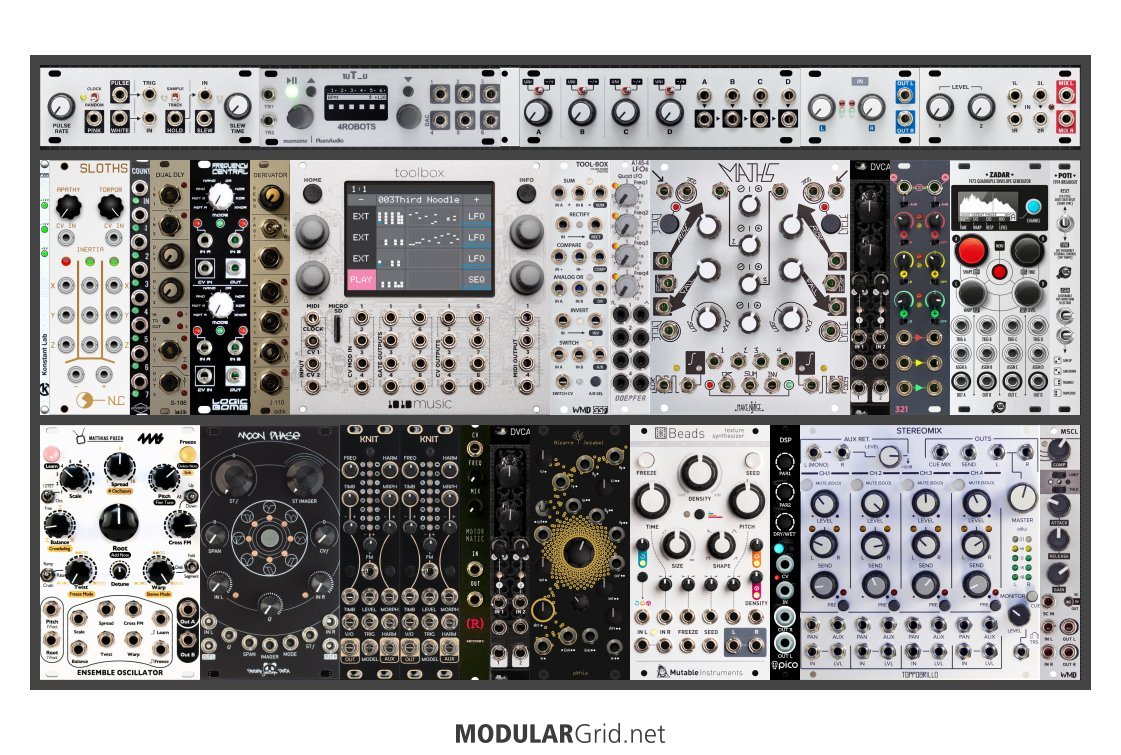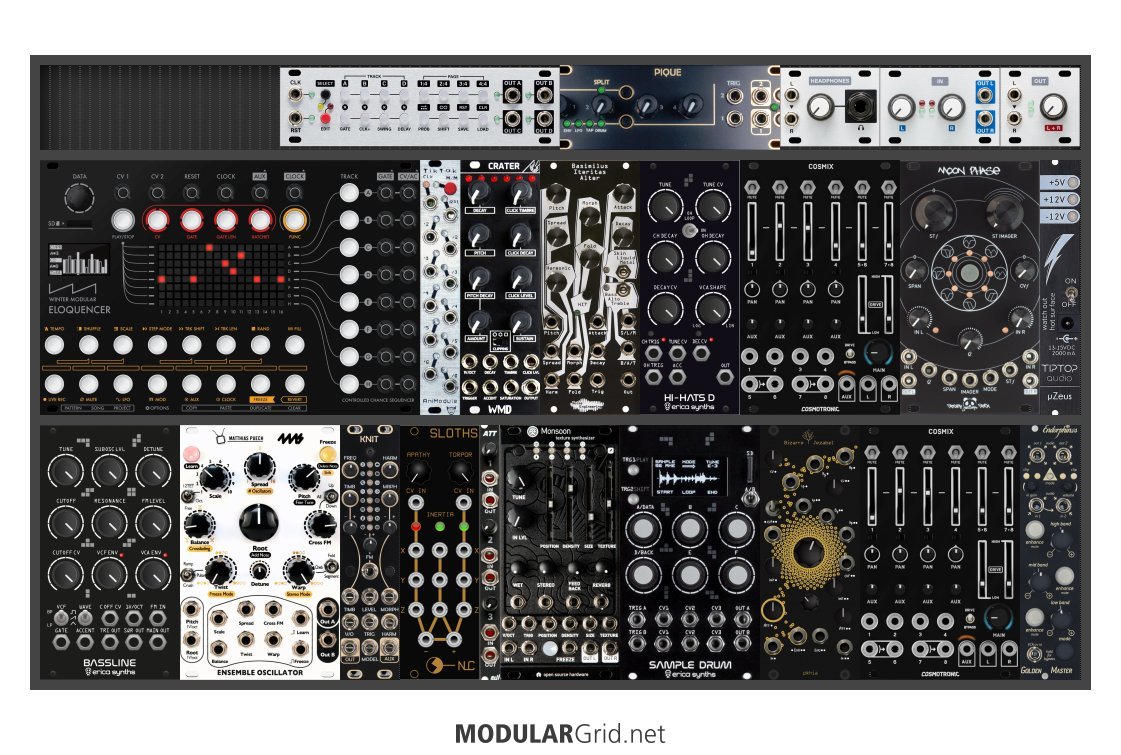I had a bash at this...but it should be noted that I've "exorcised" the drum functionality. Sort of.

Yeah, it's sorta different. But at the same time, more solid and less confusional. Normally, I use the upper row for "voicing", but given the timing situations inherent in the build, I opted to reverse the upper and lower 3U rows here. Here's why...
Tile row: OK...there's a Noise Tools tile at the left end. Not only does this provide a sample/track & hold and noise, it also gives you a slew limiter AND...most importantly...a single clock control for global tempo, if circumstances dictate. And the reason for being able to use one knob for all clocking is right next to it: a Plum Audio Temps Utile, which can reprocess that single clock signal into several channels of...STUFF. The QuadrATT is next for attenuation, polarization, submixing, etc. Then the Audio In...and a surprise, the Intellijel Stereo Mixer. Now...remember what I said about "sort of" removing the drums? This is part of the "sort of". Instead of leaving the excess of drum modules in the build (seriously...a drum machine is a FAR better and cheaper way to go), I removed them, but put in the MSCL stereo comp/limiter at the right end of the bottom row and the extra stereo input on the "output" (now the Stereo Mixer, which connects directly to the cab's 1/4" jacks) so that you can route a stereo drum machine feed into the modular, screw around with it some, MASH the crap out of the dynamics so it bangs properly, then mix that stereo signal onto the main synth's stereo out.
Top 3U: Konstant Labs PWRchekr for monitoring the DC busses, the Triple Sloths, then four modules for messing around with clock signals. The COUNT is a pulse counter, outputting gates for each "tick" in a sequence from 0-7. Then a Ladik Dual Delay is next, for shifting clock pulses in time. The "meat" here is in the middle, though, where you'll find a dual Boolean logic module, Frequency Central's Logic Bomb...and after that is a Ladik Derivator, which generates gates based on incoming CV behavior. All of those modules, taken together, are capable of serious alterations of your clocking signals. And right after that, of course, is the sequencer; the Eloquencer was just too HUGE, so I went with a similarly-featured but smaller device, 1010 Music's Toolbox...also eight channels, but with touchscreen control, micro SD sequence storage, and BOTH analog and MIDI signal outputs. SSF's wonderful Tool Box multiutility module then gives you some waveshaping, a comparator, an arithmetical CV processor, inverter, diode OR combiner, and a 2-in/1-out electronic switch. Following this are four free-run LFOs, Maths, then an After Later DVCA which is a pair of VCAs based on the Veils design that also offers 2-into-1 mixing. Next to that is a CV/modulation manipulator/mixer, Frap's handy 321. And lastly, envelopes courtesy of a Xaoc Batumi/Poti.
Bottom 3U: Ensemble Oscillator, then this is paired with the Moon Phase stereo VCF. After that are TWO Knits (two, because you want to be able to detune them to thicken up the sound) then a Recovery Motormatic v2, which is a ring modulator into which you can feed both Knits or, if you want something more off-kilter, just one Knit and then you'll use the Motormatic's internal (and somewhat ill-behaved, which can be quite fun) sine oscillator. Another DVCA then controls the dynamics of the Knit outputs before this gets sent to the phkia VCF/VCA combo. Then instead of the Monsoon, I tossed in its logical successor, namely Mutable's Beads. Last section handles mixing and output levels, starting with a very simple stereo processor, an Erica PICO DSP for providing basic reverb, chorus, phasing etc. This becomes VERY useful with the Toppobrillo Stereomix2, which is a 4-in, stereo-out performance mixer. This mixer has CV over level, panning, AND FX send on each input channel, which also have a CUE and MUTE function on each. The CUE is useful for tuning, etc via the Stereomix2's headphone preamp...OR you could use it to feed the sidechain on the MSCL comp/limiter. The main purpose of this is, of course, to "crunch up" the drums via the external stereo in, then feed this to the Stereo Mix tile...but you can also send the drums directly across to the Stereo Mix tile and then use the MSCL to hammer the crap out of some other signal.
So, why no drum modules here? Basically, it has to do with space and cost; let's say that your basic drum module is, oh, an average of 8 hp width, plus you also need its sequencer, which also eats space bigtime. Now, if you want to emulate, say, a Roland TR-909, you'll need ten modules for the voicing, plus a honkin' big sequencer such as Erica's Drum Sequencer...which burns 42 hp in of itself. Soooooo...assuming each drum module averages $200 ($2000) plus the Erica ($600) and a cab for 122 hp (or more) of housing for JUST those things, you could probably buy an ORIGINAL Roland TR-909 (albeit in "beater" condition...for "nice", double that) at today's typical 2nd-hand prices. So, uh...yeah, screw that. It's far better to make the synthesizer more elaborate and capable, because you can get ample drums for LOADS less in a format that steals a minimum of module space by just getting a good drum machine, and you then have things in the synth to mess with the drum machine's feed. This is how it really works...instead of trying to make a modular into a specific device, it makes more sense to use a PROPER modular's capabilities to mess with external signals, because whatever you use internally can ALSO quite often be used on external audio. And also, you can easily crosspatch control signals from various devices, such as clocking everything from ONE device (easy-peasy, given that nearly all synth companies use a +5V gate/trigger for clocking). So the best purpose for modulars is often to use 'em as a "signal nexus"...sort of a massive spaghetti-bowl-interchange of signals coming and going all over. That's what's up here.



